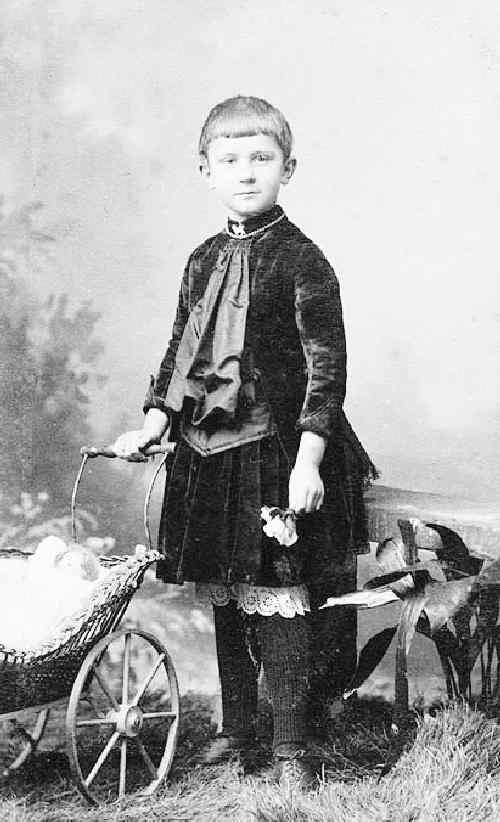
German Children's Hair Styles: Individual Child (probably 1880s)

Figure 1.--While we have noted relatively few German boys with long hair in the 19th and ealy 20th century, we note quite a number of girls with short hair. This portrait is unidentified, but we believe is a girl. Image courtesy of the Deutsche Strumpf Museum
|
This child looks to be about 7 years old. We had at first glance thought the child was a boy because of the short hair. Virtually all the other aspects of the portrait suggest that thechild is a girl. The child wears a dress with lace pantalettest and pushed a doll buggy. Sone German boys wore dresses at the time, but not usually by this age. The doll and baby buggy, however, are strong indicators that the child is a girl. We believe the image is German, but there is not studio indication on the card.
The Child
This child looks to be 6-7 5 years of age. That is, however, only a guess on our part. The face looks rather boyish. Has it not been for the doll and baby buggy I would have been more inclined to idntigy the child as a boy.
Chronology
The image is undated. We can only estimate the date. It looks like a 1880s portraitto us, but the early 1890s is possible. The style of the photograph and the dress style suggst the 80s to us. The prominent pantalettes suggest that it was probably not thge 1890s or at least very early in the 90s.
Location
We believe this is a German girl. The background shows that this is obviously a studio portrait. Unlike many late 19th century portraits, the photographic studio which would show where the portrait was taken is not indicated on this portrait.
Hair Style
The child has a standard bangs haircut. We have noted many German boys with this hair style. German girls also wore bangs, but not usually cut this short.
Clothes
The child wears a dark velvet dress. It is somewhat difficult to make out the details of the garment. It looks to be a velvet dress. I'm not sure what the light-colored vertical elenents are extending down from the collar. The collar is very plain. The dress has noth a jacket-like upper part and a plain skirt. It is worn with pantalettes extending well below the hem and dark long stockings. We generally note that by the 1880s, pantalettes did not extend this far below the hem. Pantalettes this far below the hem was more common in the 1860s and earlier. Also they were often worn with socks rather than dark long stockings. Here there appeas to have been differences between countries. German and Ameriucan children, for example, were more likely to wear long stockings than French and British children. Boys in the 19th century did wear dresses, but the available photographic record suggests that most German boys by this age had been breached.
Props
It was not just girls who played with dolls, but dolls are a stronger indivator that the child probably is a girl. This is especially the case with a bany buggy. I'm not sure what the child is holding in the left hnd, it may be a flower.
Reader Comment
A German reader writes, "What an interesting picture. The face looks so boyish but everything around (dress, flower, doll) is absolutely girlish. The dress reminds me of a cdv in my collection, which I estimate was taken in the 1880s."
Christopher Wagner

Navigate the Boys' Historical Clothing National Hair Style pages:
[Return to the Main German hair gender page]
[Main National Boys Hair Style page]
[Dutch hair styles]
[French hair styles]
[German hair styles]
Navigate the Boys' Historical Clothing German pages:
[German choirs]
[German youth groups]
[German school uniforms]
[German royalty]
[German sailor suits]
[Lederhosen]
[Ethnic]
[Tights]
[Long stockings]
Navigate the Boys' Historical Clothing Web Site:
[Introduction]
[Activities]
[Biographies]
[Chronology]
[Clothing styles]
[Countries]
[Bibliographies]
[Contributions]
[FAQs]
[Glossaries]
[Satellite sites]
[Tools]
[Boys' Clothing Home]
Created: December 15, 2002
Last updated: December 15, 2002



